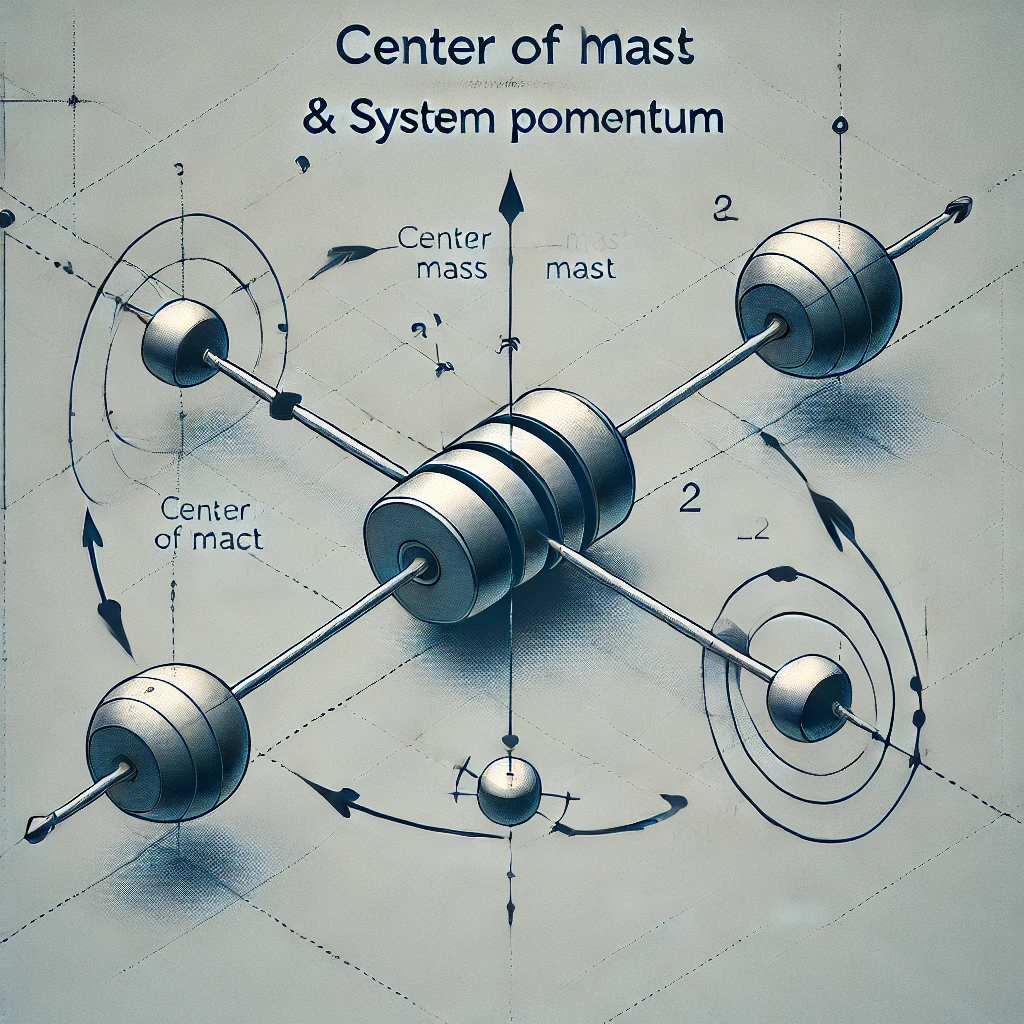Center of Mass and System Momentum
The center of mass and system momentum are fundamental concepts in physics that describe the collective motion of a system of particles or objects.
Center of Mass (COM)
The center of mass is the point where the mass of a system is considered to be concentrated. It is the weighted average position of all the masses in the system.
Center of Mass Formula
For a system of particles: R⃗COM=∑mir⃗i∑mi\vec{R}_{\text{COM}} = \frac{\sum m_i \vec{r}_i}{\sum m_i}
Where:
- mim_i: Mass of the ii-th particle
- r⃗i\vec{r}_i: Position vector of the ii-th particle
- R⃗COM\vec{R}_{\text{COM}}: Position vector of the center of mass
For a continuous mass distribution: R⃗COM=∫r⃗ dm∫dm\vec{R}_{\text{COM}} = \frac{\int \vec{r} \, dm}{\int dm}
System Momentum
The total momentum of a system is the vector sum of the individual momenta of all the particles in the system. It is given by: P⃗system=∑miv⃗i\vec{P}_{\text{system}} = \sum m_i \vec{v}_i
Where:
- P⃗system\vec{P}_{\text{system}}: Total momentum of the system
- mim_i: Mass of the ii-th particle
- v⃗i\vec{v}_i: Velocity of the ii-th particle
The momentum of the system can also be expressed in terms of the center of mass: P⃗system=MV⃗COM\vec{P}_{\text{system}} = M \vec{V}_{\text{COM}}
Where:
- M=∑miM = \sum m_i: Total mass of the system
- V⃗COM\vec{V}_{\text{COM}}: Velocity of the center of mass
Relationship Between Center of Mass and System Momentum
The motion of the center of mass is directly related to the total momentum of the system:
- The velocity of the center of mass is: V⃗COM=P⃗systemM\vec{V}_{\text{COM}} = \frac{\vec{P}_{\text{system}}}{M}
- If no external forces act on the system, the momentum of the system and the velocity of the center of mass remain constant: P⃗system=constantandV⃗COM=constant\vec{P}_{\text{system}} = \text{constant} \quad \text{and} \quad \vec{V}_{\text{COM}} = \text{constant}
Key Principles
- Internal Forces: Internal forces between particles in the system do not affect the center of mass motion. Only external forces influence it.
- Newton’s Second Law for COM: F⃗external=MdV⃗COMdt\vec{F}_{\text{external}} = M \frac{d\vec{V}_{\text{COM}}}{dt} This implies the center of mass moves as if all external forces were acting on a single point with mass MM.
- System Momentum Conservation: If the net external force on a system is zero, the total momentum of the system (and hence the velocity of the center of mass) remains conserved.
Example Problem
Two particles with masses m1=3 kgm_1 = 3 \, \text{kg} and m2=5 kgm_2 = 5 \, \text{kg} are located at positions r⃗1=(2,4) m\vec{r}_1 = (2, 4) \, \text{m} and r⃗2=(6,1) m\vec{r}_2 = (6, 1) \, \text{m}. Find the center of mass.
Solution:
R⃗COM=∑mir⃗i∑mi\vec{R}_{\text{COM}} = \frac{\sum m_i \vec{r}_i}{\sum m_i} R⃗COM=(3)(2,4)+(5)(6,1)3+5\vec{R}_{\text{COM}} = \frac{(3)(2, 4) + (5)(6, 1)}{3 + 5} R⃗COM=(6,12)+(30,5)8=(36,17)8\vec{R}_{\text{COM}} = \frac{(6, 12) + (30, 5)}{8} = \frac{(36, 17)}{8} R⃗COM=(4.5,2.125) m\vec{R}_{\text{COM}} = (4.5, 2.125) \, \text{m}
Thus, the center of mass is located at (4.5,2.125) m(4.5, 2.125) \, \text{m}.
Applications
- Astrophysics: Understanding planetary orbits and the motion of binary stars.
- Engineering: Designing stable structures by determining the COM.
- Collisions: Analyzing motion in multi-body collisions using momentum conservation.
- Sports: Predicting motion in gymnastics, diving, and other sports involving body rotation.
The center of mass and system momentum principles are crucial for analyzing and predicting the motion of complex systems.
https://zireemilsoude.net/4/8591310

Leave a Reply